Inscriptions, texts nos. 20-39
Browse the RIAo Corpus [http://oracc.museum.upenn.edu/riao/pager/]
Quick links
Objects from Ashur (nos. 25-27)
Monumental Inscriptions from Fort Shalmaneser's Southern Wing (nos. 28-37)
Objects from Nineveh and Ashur (nos. 38-39)
20 21 22 23 24 25 26 27 28 29 30 31 32 33 34 35 36 37 38 39
20-24, Rock Reliefs
20
A rock face with a portrait of the king carved in relief and an inscription engraved on both sides is found near the Kenk Boğazı/Kenk Gorge, along the Upper Euphrates and about sixty kilometers northest of Gaziantep. The identificartion of the site of the relief with a place name from the ruler's inscriptions is to date problematic and A. O. Tașyürek (1979, 52-53) finds it unlikely to identify it with the Mount Šītamrat quoted in the inscription.
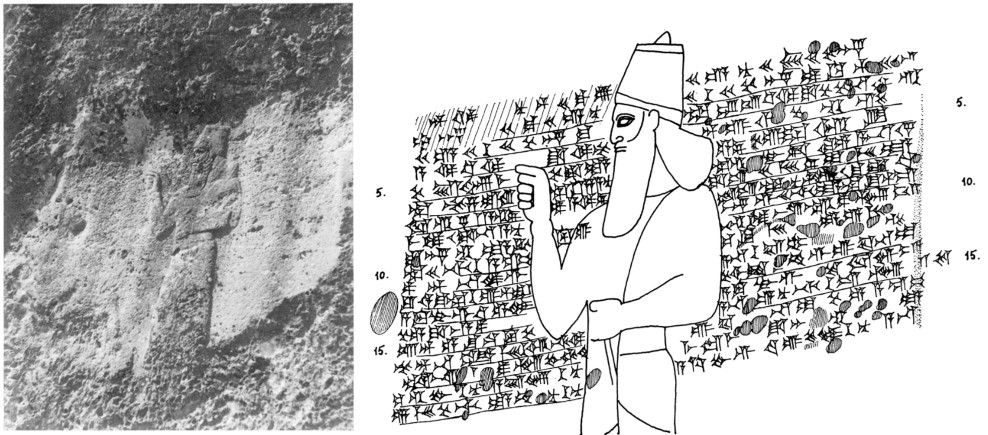
Elaboration from: Tașyürek, Iraq 41 pls. XV and p. 51.
After an introduction with name, epithets, genealogy and a brief summary of the military enterprises (in geographic order) of the king (ll. 1–6a), the remaining thirteen lines record the campaigns of conquest of Tīl-Barsip (ll. 7b–15a) in the second year of reign (857 BC) and Šītamrat on the Euphrates, in the fourth (855).
Access the composite text [http://oracc.museum.upenn.edu/riao/Q004625/] of Shalmaneser III 20.
Bibliography
21-24, Tigris Tunnel Reliefs
21
The following four texts belong to the same group of inscriptions
that were engraved with a portrait of the king on rock faces
at the sources of the Tigris, where the river
Sebeneh-Su goes through a tunnel. The four inscriptions really on two
pairs of original texts, nos. 21 and 22 being one pair and nos. 23 and
24 beign the other. Nos. 21-22 are the earliest in date and describe
the "third campaign" to Nairi in 852 BC (seventh palû), whereas
the other two inscriptions record the events as far as 850 (ninth
palû) and 845 (fourteenth palû). A depiction and
description of the
craving of the reliefs and the inscriptions is most probably the one
given also in one of the scenes and epigraphs of Shalmaneser's Balawat
Gates (nos. 77-78 = L6).
An inscription of Tiglath-pileser I (no. 15) is also present on the same rock
face, also accompained by a portrait of the ruler.

Elaboration from: Entrance of the Tigris tunnel, Balawat Gates, and portrait of Tiglath-pileser I (see this ruler's text (no. 15): King, Bronze reliefs (1915) pl. 54-9, and Börker-Klähn, Bildstelen no. 149.
Texts nos. 21-22 are very similar and have been sometimes identified as duplicates in the older literature (Grayson 1996, p. 92). They both begin with an invocation of gods followed by name, epithets and genealogy of the ruler, and a description of the campaign to Gilzanu and to Nairi.
Access the composite text [http://oracc.museum.upenn.edu/riao/Q004626/] of Shalmaneser III 21.
Bibliography
22
See introduction to text no. 21.
Access the composite text [http://oracc.museum.upenn.edu/riao/Q004627/] of Shalmaneser III 22.
Bibliography
23
The second pair of inscriptions engraved on the reliefs of the Tigris tunnel (see text no. 21) deal, after an introduction that has the royal name, epithets and a brief description of conquest (text no. 23: 1—19a; 24: 1—10), with the campaign against Babylonia and Chaldea, which took place in Shalmaneser's ninth year of reign in 850 BC (23: 19b—20; 24: 11—14) and with the fourth conflict with the Damascene coalition, in 845, his fourteenth year (23: 21—27; 24: 14—17).
Note that Shalmaneser's annals refer to the moment in which these events were inscribed at the source of the Tigris in his fefteenth year of reign (844; see text no. 6 [http://oracc.museum.upenn.edu/riao/Q004611/] iii 35—38; 8 [http://oracc.museum.upenn.edu/riao/Q004613/]: 48'—49'; 10 [http://oracc.museum.upenn.edu/riao/Q004615/] iii 27—29; 14 [http://oracc.museum.upenn.edu/riao/Q004619/]: 92—93. Cf. also the Balawat Gates epigraph no. 78). In the old literature, the two texts have been sometimes treated as duplicates because of their similarities, but they have major differences. Schrader thought text no. 23 to belong to Tukulti-Ninurta II's corpus, which was thereofre edited in Scheil (see Bibliography below).
Access the composite text [http://oracc.museum.upenn.edu/riao/Q004628/] of Shalmaneser III 23.
Bibliography
24
See introduction to text no. 23
Access the composite text [http://oracc.museum.upenn.edu/riao/Q004629/] of Shalmaneser III 24.
Bibliography
25
The statue of a seated Shalmaneser (135 cm high) with an inscription engraved on the sides and the back of the throne was found by A. H. Layard at Ashur in 1847. Its original location remains unknown, but from Layard's description of its finding, W. Andrae was able to suggest that it had been originally erected inside the Tabira Gate, which is also mentioned in the inscription itself (ll. 40-41). On the monument are notable two different damages: the head of the king is broken off, which suggest a probable beheading of the statue in a period after its carving; however, the statue shows also the presence of flaws that clearly happened before that the inscription was engraved, since no sign is missing from the lines affected by them.
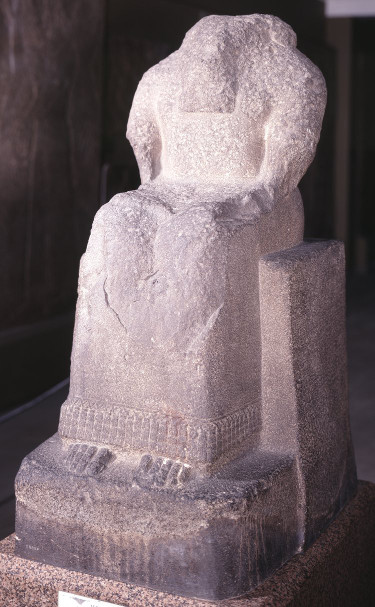
BM 118886 © The Trustees of the British Museum
The inscription begins with an introduction (ll. 1-20) that has the ruler's name, his epithets,
genealogy and a brief geographical summary of his conquests that
includes the campaign in Babylonia in his ninth year of reign (and
dates the text to shortly after 850 BC). The following lines constitute
the core of the inscription, and describe the extensive works that
Shalmaneser did on the walls and
the gates of Ashur (ll. 21-31). Such records have been
confirmed by the study of Andrae (1913, 99), who suggested that at the
north-east corner of the city, the
ruler had rebuilt the inner and outer walls and fully enclose the
terrace of Tukulti-Ninurta I's New Palace, thus creating a unified barricade,
and that similar operations probably took place in other parts of the
walls.
The following pair of lines (ll. 32-33) record the restoration
of a statue of Kidudu, guardian of the wall. This is followed by short
blessing formula for the later prince who will take care of walls and
inscriptions (ll. 32-34) and by a final part
dedicated to the epithets of the two walls and the eight gates,
presumably those affected by the renovation works (ll. 37-47). Note
that this last passage is to be found almost identical in the
so-called Address Book of the Gods (Frankena 1954, 124-125; Menzel
1981, 146-156; George 1992, 176-17).
Access the composite text [http://oracc.museum.upenn.edu/riao/Q004630/] of Shalmaneser III 25.
Bibliography
26
A small golden tablet (2.9x4.1 cm), although not scientifically excavated, presumably from the walls of the city Ashur. Andrae suggests that originally it was deposited in an alabaster box similar to the one listed here as text no. 27
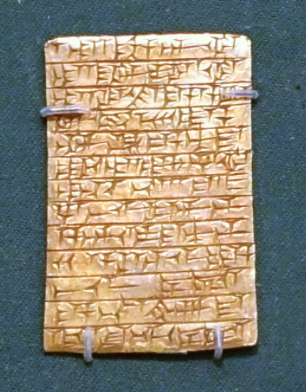
A 02529 (Reverse) © Oriental Institute Museum, University of Chicago
Like the inscription on text no. 27, the tablet is characterized by a clumsy style and has a similar content, referring to Tukulti-Ninurta I as earlier builder of the city walls. A reference to the Babylonian campaign indicates a date of the inscription shortly after 850 BC (ninth year of reign of Shalmaneser).
Access the composite text [http://oracc.museum.upenn.edu/riao/Q004631/] of Shalmaneser III 26.
Bibliography
27
A stone box (25x22.5x14 cm) was found at Ashur, in the ruins by the outer wall. According to Andrae's recostruction, the box must have been rolled down from a previous position and the agate beads on which was found resting must have been originally sotred in it. Furthermore, it is presumable that the box contained some inscribed tablets, and the golden tablet text no. 26 might have been one of them. The style and content of the two texts are very similar, but unlike text no. 26, the present inscription doesn't have any indication of date.
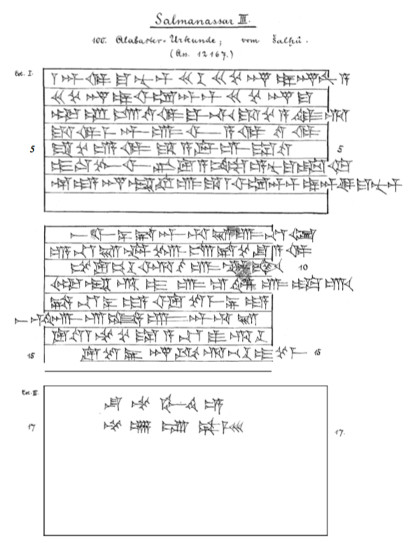
VA 08836. KAH 2 no. 100
Access the composite text [http://oracc.museum.upenn.edu/riao/Q004632/] of Shalmaneser III 27.
Bibliography
28-37: Monumental Inscriptions from Fort Shalmaneser's Southern Wing
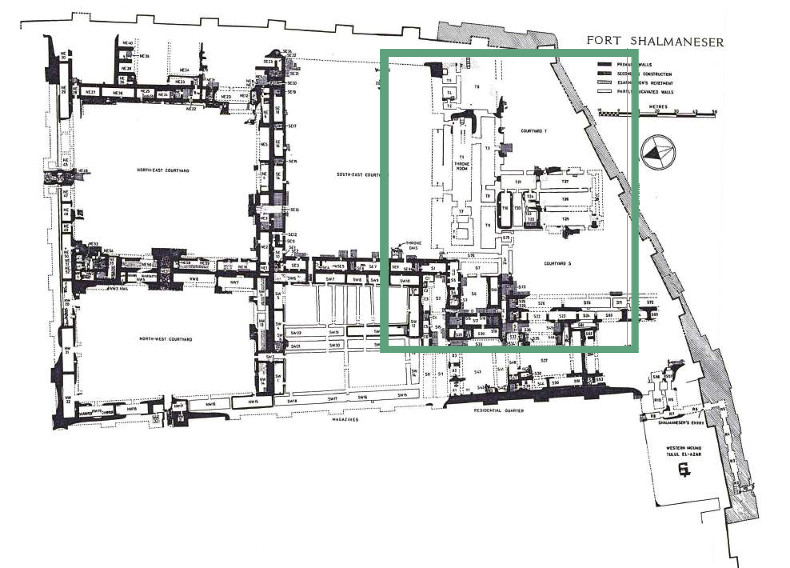
Map: British Institute for the Study of Iraq
28, Fort Shalmaneser's Trhone Base (Room T1)
A throne dais, one of the two discovered at Fort Shalmaneser, in Nimrud, was
found in the throne quarters, room T1 of the fort. The stone base was
discovered in situ, leaning against the east wall and it is
composed by two blocks of limestone, together measuring 382x228 cm. The east block is rectangular and
has a number of recesses on its surface in correspondence with, and in
order to keep stable, the
legs of the throne and the footstool. The west block is T-shaped and
approximately at the half of it is stepped down to about 9 cm lower than
the rest of the surface.
The monument is inscribed on all its surfaces, inluding under the east
block (see, text no. 57), alone or alongside the
reliefs that are carved on the front side of the west block, visible
to the audience. The inscription has been divided in five parts
according to position and subject, following the order suggested by
Hulin, and each part is here treated as a separate text, as done by
Grayson in his edition.
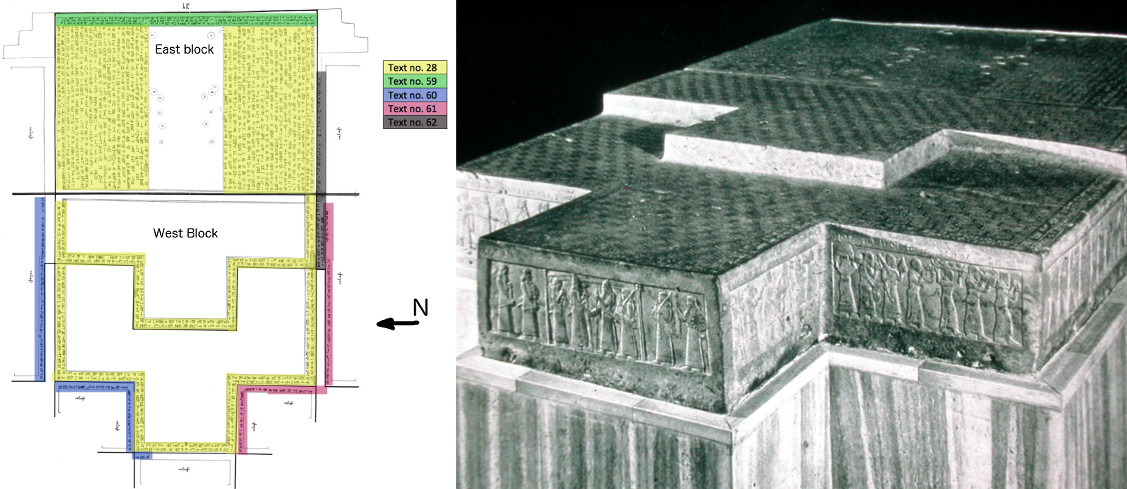
IM 065574. Elaboration from Hulin 1963 and A. Moortgat, The Art of Mesopotamia (1969) fig. 269
The text edited here is engraved on the upper surface of the east block, divided in two halves, twenty lines on the northern side, running east-west, and twenty on the southern one, running west-east. Further four lines are engraved on the edges of the step of the western block, facing west.
Text no. 57 is engraved under the east block and is a duplicate of the first six lines of the main inscription, plus an attestation of Šamaš-bēla-uṣur being the commissioner of the monument as in text no. 62.
Text no. 59 is engraved on the eastern side of the eastern block, along the wall, running south-north, and written in a rather smaller script. However, according to Hulin, it is the ideal continuation of the main inscription (and for this reason here edited as ll. 45-47) and in a sense a label embracing the whole throne base, since it describes the central scene carved in relief and is inscribed at the very bottom of the monument, invisible to the audience.
Text no. 60 is an epigraph to the relief on the northern side of the dais.
Text no. 61 is an epigraph to the relief on the southern side of the dais.
Text no. 62, finally, is the building tag of the monument, recording the provenance of its material and the commissioner, Šamaš-bēla-uṣur, governor of Kalḫu.
The narrative structure of the present text is unusual. The
presence of two clear dates, the accession and first year (859-858 BC;
l. 10) and the
thirteenth year (846; l. 34) give to the inscription the shape of a
chronological account of the ruler's campaigns. However, Schramm's
analysis has proven a different picture. Correspondence between lines
and years of reign are, accordingly, the following:
ll. 10-26 (and 42?): first year (859-858)
ll. 26-28: fourth year (855)
ll. 29-34: sixth year (853)
ll. 34-36: thirteenth year (846)
ll. 37-42: third year (856)
ll. 42-44: fourth year (855)
ll. 44: fifth year (854)
The thirteen year appears however to be the latest date present in the
inscription and, therefore, it can be assumed that the monument was
carved shortly after that year. A direct relation between function of
the monument and inscription is the sentence that seems to have been
expressly composed for engraving on it, i.e.: "valiant man who with
the support of Aššur, his lord, has put all lands under his feet like
a footstool" (l. 10; cf. text no. 30 [http://oracc.museum.upenn.edu/riao/Q004635/]: 11 and Šamši-Adad V text no. 1 [http://oracc.museum.upenn.edu/riao/Q004738/]
ii 15-16).
Access the composite text [http://oracc.museum.upenn.edu/riao/Q004633/] of Shalmaneser III 28.
Bibliography
29, Fort Shalmaneser's Trhone Base (Courtyard SE)
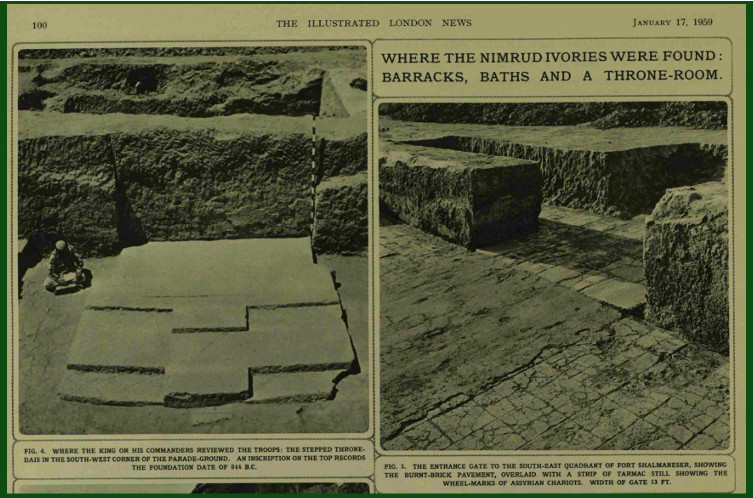
Left: photo of the SE courtyard throne dais, from London Illustrated News, January, 17 1959. Image © Illustrated London News Group
Two adjoining limestone slabs used most presumably as a throne dais
were discovered under a secondary pavement near the corner of the
south-eastern courtyard of Fort Shalmaneser, at Nimrud. Although
fitted into a shallow niche, it appears clear that the throne base was
not in its original position, as it may have been removed, perhaps from the near (secondary) throne room S5, either to
attend the review of the army in the courtyard or by later
occupants for unknown reasons. The slab adjoining
the wall measures 291x170 cm and is inscribed in two panels measuring
144x87 cm separated by a blank space 94 cm wide.
The text has many similarities with other inscriptions found at the
fort (cf. texts nos. 30-37), with a non-chronological narrative
structure. Following the lines the following campaigns are
narrated:
ll. 8b-12a: fourth year (855)
ll. 10b-20: eleventh year (848)
ll. 24-26: first year (858)
ll. 30-34a: fifteenth year (844)
ll. 42b-48: eighth and ninth years (851-850)
Access the composite text [http://oracc.museum.upenn.edu/riao/Q004634/] of Shalmaneser III 29.
Bibliography
30-37, Door Sills
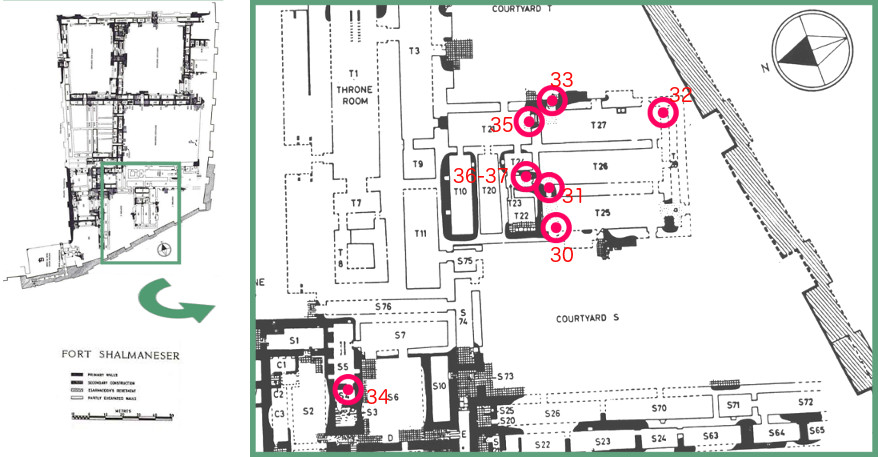
Elaboration from Map of the British Institute for the Study of Iraq
30
A number of door sills have been found in teh southern
wing of Fort Shalmaneser engraved with similar texts, here edited as
nos. 30-37. This is the longest version of such inscriptions is on a
large slab (139x243 cm) found in situ in the doorway of the west side of room T25, belonging to
the throne-room complex.
The long introductory part of this text dedicated to the ruler's
epithets duplicates in many places the similar passage in text
no. 28 (30: 3b-12a // 28: 2b-10a). Then
the inscriptions includes accounts of events from the fourth (855;
ll. 20a-21), eighth-ninth (851-850; ll. 28b-32a), eleventh (848;
22-28a), and fifteenth (844; ll. 18b-20a) regnal years. Dating of the
threshold is then presumably short after 844.
The last lines attest the object as a donation from Šamaš-bēla-uṣur,
governor of Kalhu (as also are texts nos. 31 and 62).
None of the following inscribed door sills has an excavation number (see Dalley and Postgate, Fort Shalmaneser p. 265).
Access the composite text [http://oracc.museum.upenn.edu/riao/Q004635/] of Shalmaneser III 30.
Bibliography
31
An inscription engraved on a number of door sills, all discovered in situ at Fort Shalmaneser (ex. 1 in the doorway between rooms T25 and T26, ex 2 and 3formed the western and eastern parts of the threshold into room T3). After an introductory part, the text inlcudes accounts of the first (858; ll. 8-9), and fifteenth (844; ll. 6-7) regnal years. In the final lines the commission of the slab by Šamaš-bēla-uṣur, governor of Kalhu, is also recorded.
Access the composite text [http://oracc.museum.upenn.edu/riao/Q004636/] of Shalmaneser III 31.
Bibliography
32
An inscription engraved on a door sill found in situ in the doorway between rooms T27 and T28 of Fort Shalmaneser. After an introductory part, the text inlcudes accounts of the first (858; ll. 5), and fifteenth (844; ll. 3b-4a) regnal years.
Access the composite text [http://oracc.museum.upenn.edu/riao/Q004637/] of Shalmaneser III 32.
Bibliography
33
An inscription engraved on a door sill found in situ at Fort Shalmaneser, in the doorway leading from east into room T27. After an introductory part, the text inlcudes accounts of the first (858; ll. 7b-8a), and fifteenth (844; ll. 5-6a and 9b-10a) regnal years.
Access the composite text [http://oracc.museum.upenn.edu/riao/Q004638/] of Shalmaneser III 33.
Bibliography
34
An inscription engraved on a door sill found in situ at Fort Shalmaneser, in the doorway leading into room S4. After an introductory part, the text inlcudes accounts of the first (858; ll. 8b-10a), and fifteenth (844; ll. 4b-5) regnal years.
Access the composite text [http://oracc.museum.upenn.edu/riao/Q004639/] of Shalmaneser III 34.
Bibliography
35
An engraved stone threshold found between rooms T 27 and T 21 of Fort Shalmaneser. The text should be dated no earlier than the 15th year of Shalmaneser [http://oracc.museum.upenn.edu/riao/theassyrianempire883745bc/shalmaneseriii/index.html] (844 BC), due to the mention to events that took place in that year. For other similar inscribed objects discovered at Fort Shalmaneser, see the introduction to text no. 30.
The threshold measures 184×49 cm, while the panel in which the inscription appears measures 172×27.5 cm. No excavation number was assigned to the object (see Dalley and Postgate, Fort Shalmaneser p. 265), which was left in situ, and the inscription could not be collated. A draft transliteration of the text was found among P. Hulin's papers.
Access the composite text [http://oracc.museum.upenn.edu/riao/Q004640/] of Shalmaneser III 35.
Bibliography
36
Engraved stones found at Fort Shalmaneser bear this short text. It is preserved on two exemplars: ex. 1 is a door sill found between rooms T23 and T26, measuring 109×147 cm; ex. 2 is a bolt socket found in room T24, measuring 106×52 cm. Both objects were left in situ. The two texts are identical except for the omission in ex. 2 of e-bir and line 7, presumably due to lack of space. The inscription is similar to those engraved on several door sills in the same building (see the introduction to text no. 30). One ought to date the text no earlier than the 15th year of Shalmaneser [http://oracc.museum.upenn.edu/riao/theassyrianempire883745bc/shalmaneseriii/index.html]'s reign (844 BC), due to the mention of events that took place in that year (lines 6-7).
Access the composite text [http://oracc.museum.upenn.edu/riao/Q004641/] of Shalmaneser III 36.
Bibliography
37
An engraved stone found at Fort Shalmaneser bears this short text. A similar text is to be found on various door sills also found at Fort Shalmaneser (see the introduction to text no. 30 of this monarch). One ought to date the text no earlier than the 15th year of Shalmaneser [http://oracc.museum.upenn.edu/riao/theassyrianempire883745bc/shalmaneseriii/index.html]'s reign (844 BC), due to the mention of events that took place in that year (line 5).
Access the composite text [http://oracc.museum.upenn.edu/riao/Q004642/] of Shalmaneser III 37.
Bibliography
38
Two stones from a statue found at Nineveh reveal, although badly
damaged, an inscription clearly from the reign of Shalmaneser III. The
text starts with a (very fragmentary) dedication to Ištar followed by
numerous epithets. After a break, the text continues more clearly
with the king's genealogy, some more epithets and a brief and non-chronological
description of some of his conquests, namely the sixteenth campaign
(843 BC; ll. 10'b-13'a; cf. also parallels with text no. 10 iii 33-36), and the ninth year's campaign to Babylon
(850; ll. 13'b-16'; see the parallel in texts nos. 25: 17-19 and 59: 46-47.).
Genealogy and epithets (ll. 1'-10') have many parallels, of which
particularly notable is text no. 8: 20-37.
Access the composite text [http://oracc.museum.upenn.edu/riao/Q004643/] of Shalmaneser III 38.
Bibliography
39
Several clay cones and fragments of clay cones from the Anu-Adad
temple at Ashur (cf. text no. 42) are written with the present text,
which records the construction of that temple in 839 BC.
The master text for the composite version here edited is a conflation
of exs. 1 and 2.
Access the composite text [http://oracc.museum.upenn.edu/riao/Q004644/] of Shalmaneser III 39.
Bibliography
Jamie Novotny, Nathan Morello, Yehonatan Hershkovitz & Poppy Tushingham
Jamie Novotny, Nathan Morello, Yehonatan Hershkovitz & Poppy Tushingham, 'Inscriptions, texts nos. 20-39', The Royal Inscriptions of Assyria online (RIAo) Project, The RIAo Project, a sub-project of MOCCI, 2020 [http://oracc.museum.upenn.edu/riao/theassyrianempire883745bc/shalmaneseriii/texts2039/]